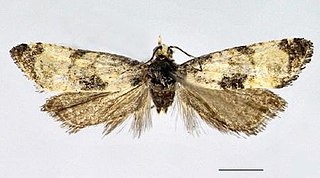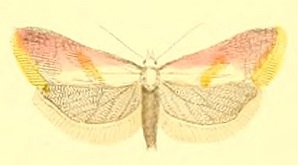
The Cochylini are a tribe of tortrix moths. It used to be classified as the subfamily Cochylinae.

Cochylis nana is a moth of the family Tortricidae. It was described by Adrian Hardy Haworth in 1811. It is found in Europe, Amur Oblast of Russia and Nova Scotia in Canada.

Cochylis is a genus of moths belonging to the subfamily Tortricinae of the family Tortricidae.

Cochylimorpha is a genus of moths of the family Tortricidae.

Cochylis hybridella is a moth species of the family Tortricidae. It is found in most of Europe, the Near East, China, Japan, Korea and Russia.

Cochylichroa atricapitana, the black-headed conch, is a moth of the family Tortricidae. It is found in China (Xinjiang) and the eastern Palearctic and most of Europe.

Cochylis discerta is a moth of the family Tortricidae. It is found in China and Mongolia.

Cochylis dubitana, the little conch, is a moth of the family Tortricidae. It is found in China (Heilongjiang) and most of Europe. and the Caucasus. It is also found in North America, where it has been recorded from Colorado, Maine, Ontario and Washington.

Cochylis faustana is a moth of the family Tortricidae. It is found in China and Russia.

Cochylis posterana is a moth of the family Tortricidae. It is found in Europe, Iran and China.

Cochylis triangula is a moth of the family Tortricidae. It is found in China in Guizhou and Yunnan.

Cochylis flaviciliana, the gold-fringed conch, is a moth of the family Tortricidae. It was described by Westwood in 1854. It is found in most of Europe and north-western Africa. The habitat consists of chalky grasslands.
Cochylis psychrasema is a species of moth of the family Tortricidae. It is found in China.
Cochylis campuloclinium is a species of moth of the family Tortricidae. It is found in Argentina.
Cochylis cataphracta is a species of moth of the family Tortricidae. It is found in Venezuela.
Cochylis eutheta is a species of moth of the family Tortricidae. It is found in Mexico in the states of Veracruz and Tamaulipas.
Cochylis fidens is a species of moth of the family Tortricidae. It is found in Minas Gerais, Brazil.
Cochylis securifera is a species of moth of the family Tortricidae. It is found in Brazil in the states of Espírito Santo and Paraná.
Cochylis philypna is a species of moth of the family Tortricidae. It is found in Brazil, where it is found from Minas Gerais to Goias.
Cochylis yinyangana is a species of moth of the family Tortricidae. It is only known from the White Sands National Park in Otero County, New Mexico and at Carlsbad Caverns National Park in Eddy County, also in New Mexico.










